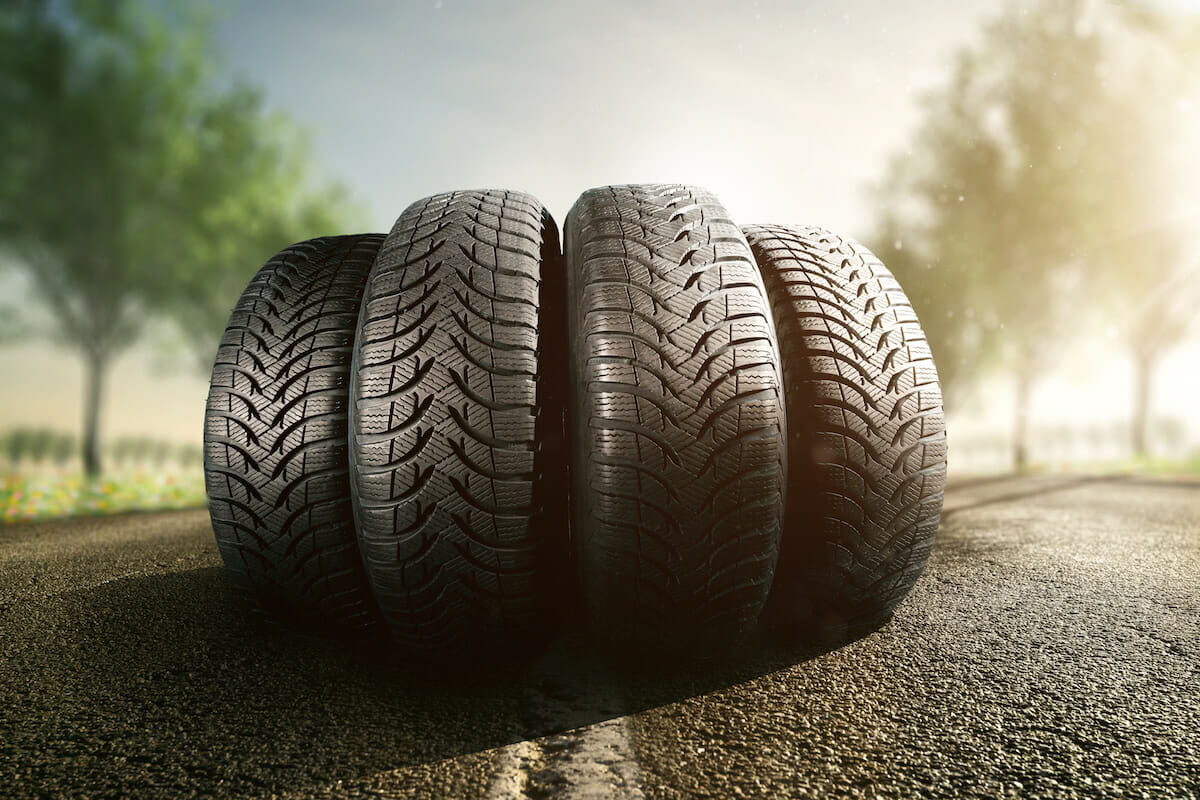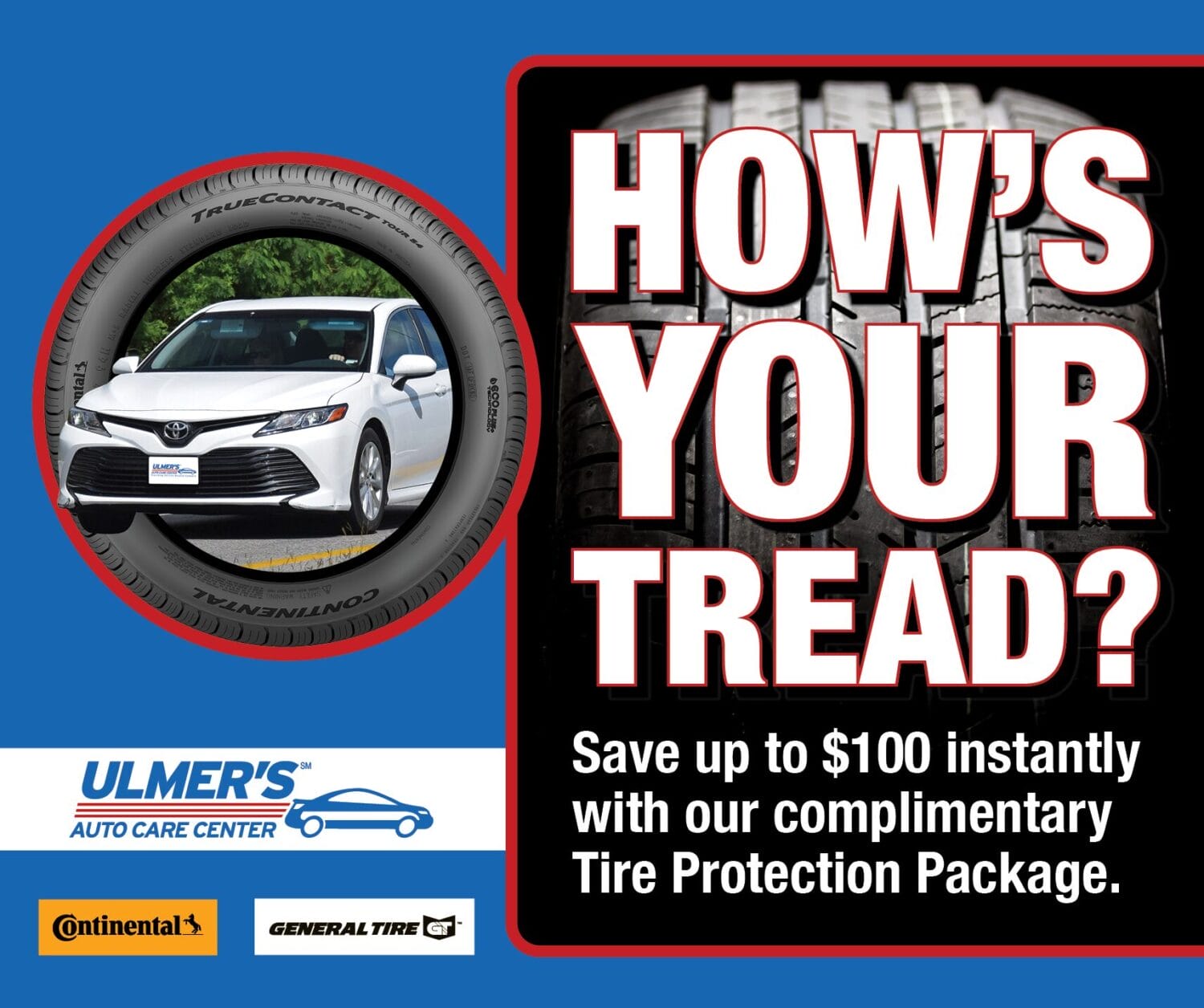Tire FAQs

Ever since automakers and rubber manufacturers teamed up in the early days of automotive history, tires and the ways they’re built, designed, and used have changed dramatically.
Here at Ulmer’s Auto Care, we’re here to help you out with any questions you may have about your vehicle’s tires and wheels. If you’re looking to purchase new tires, below is everything you need to know as a consumer in order to make an educated decision.
How often should I change my tires?
How frequently you need to replace the tires on your vehicle will depend on a variety of factors. Most owner manuals recommend switching out tires once they’ve hit the 50,000-mile mark, which is pretty standard amongst major tire manufacturers in the industry like Michelin, Firestone, and BFGoodrich. However, variables like the amount of stress your tires are under, tire pressure, and your driving style can all change the life expectancy of a set of tires.
What do the letters & numbers on my tire mean?
If you’ve ever wondered what the jumble of letters and numbers on your tire’s sidewall stood for, allow us to help clue you in. Let’s look at an example of a typical TIN (tire identification number) and unpack it piece by piece.
DOT FS 6F ABCD 2418
DOT – Short for Department of Transportation – the first part of a TIN simply marks that the tire meets all industry standards established by the government and has been certified for safe use.
FS – This is the manufacturer plant ID code. This lets you know who produced the tire.
6F – This is the tire’s size code, and is specific to the tire manufacturer.
ABCD – This is an optional code that is found in 3-4 spaces directly after the size code that brands can use to identify specific tire lines.
2418 – The final four numbers in the TIN will always mark the week and year that the tire was made. The first two numbers will always indicate the number of weeks into the year that the tire was made, while the final two numbers will always indicate the last two digits of the year. In this example, the tire was made in the 24th week of the year 2018.
What are tire ratings?
Tires are rated by the government on three different categories: treadwear, traction, and temperature. These ratings are especially useful if you’re trying to pick between similar tires from the same manufacturer. Just like the tire identification number, tire ratings are printed on the outside of the tire and give you important information on the capabilities and specs of the tire.
Treadwear
Treadwear grades give you an idea of how long your tire’s tread should last. For example, a tire with a treadwear grade of 400 should last twice as long as a tire with a grade of 200. Most standard all-weather passenger tires feature a treadwear rating in the 700-800 range.
Traction
Traction grades help clue you into the vehicle’s ability to come to a stop on wet pavement in a short distance. Traction is graded (from best to worst) AA, A, B, or C.
Temperature
Temperatures grades are used to help you tell how resistant the tire is to heat. Temperature is graded (from best to worst) A, B, or C.
What kind of tires do I need?
All-Weather Tires
For your average driver, all-weather tires hold up just fine for most of the year. Most standard passenger tires that are available to consumers are perfectly capable of providing a comfortable and safe ride in normal to moderate conditions. All-weather tires tend to see better gas mileage and longer lives than their winter and off-road counterparts.
Winter Tires
Towards the end of each fall, we recommend that you replace your all-weather tires with winter tires that have been specifically designed to handle the dangerous conditions found on roads when winter weather starts to arrive. These types of tires provide you with more traction and control in deep snow.
All-Terrain Tires
These types of tires are mainly used on vehicles with four-wheel drive capabilities and give the driver a good balance of control both on the road and off it.
Off-Road/Performance
Tires designed for rigorous off-roading or high-performance handling are specially designed to give drivers an advantage over tough-to-traverse terrain. These types of tires are more common amongst hobbyists and outdoor-lovers than every-day drivers.
What is tire alignment and how often do I need to have my tires aligned?
Tire alignment is sometimes also called wheel alignment and consists of making sure the angle of your wheels corresponds to the vehicle manufacturer’s specifications. Proper tire alignment is key to making sure that your tread wears evenly across all tires and in preventing steering issues like the vehicle pulling to one side while driving straight.
Tire Services from Ulmer’s
If you’re in the market for new tires, we want to make sure that you have all the pertinent information before you make your decision. Here at Ulmer’s, we’ll take the time to help you select a set of tires that’s right for your vehicle. We provide reliable installation, maintenance, balancing, rotation, and alignment services. Our staff has years of experience serving the Cincinnati, Milford, Anderson, OH & KY areas and we take pride in helping our neighbors out with all of their automotive repair service needs. Schedule your service with us today!





